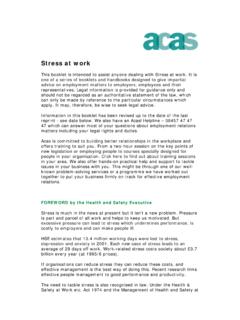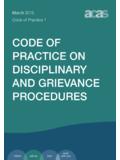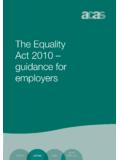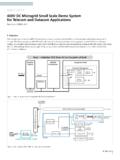Transcription of A guide February 2013 - Acas
1 1A guideFebruary 2013 MEDIATION: AN APPROACH TO RESOLVING WORKPLACE 1 CONTENTSA cknowledgements 2 Introduction 31 The impact of conflict in the workplace 52 What is mediation? 83 When can you use mediation? 114 The benefits of mediation 145 Implementing mediation in your organisation 176 Managing the mediation process 257 Evaluation 32 Conclusions 35 Useful contacts 37 References for further reading 38 MEDIATION: AN APPROACH TO RESOLVING WORKPLACE ISSUES2 This updated publication, first published in 2008 as Mediation: An employer s guide , has been produced for Acas and the Chartered Institute of Personnel and Development (CIPD) by Sarah Podro and Rachel Suff of Acas.
2 The case study research used to inform the guide was conducted and managed by the Research and Evaluation Team at Acas. A number of organisations with experience of using mediation provided valuable case study material to help inform this guide . We would like to thank the following organisations that took part in the study: Incommunities a large housing association Customer Service Direct a joint venture between Suffolk County Council, Mid Suffolk District Council and BT Ministry of Justice a large central government department Salisbury Cathedral a small/medium-sized charity University of Central Lancashire (UCLan) a large university West Midlands Police a large police force MRM marketing solutions of the participating case studies preferred to remain anonymous.
3 Medium-sized public sector addition the updated publication draws on case study materials from the Acas research study Transforming Conflict Management in the Public Sector: Mediation, trade unions and partnerships in a primary care trust (2011), by Richard Saundry, Louise McArdle and Pete Thomas (the Institute for Research into Organisations, Work and Employment (iROWE) at the University of Central Lancashire).Special thanks go to Acas colleagues Gill Trevelyan, Sarah Vintner and Keith Mizon, to the Acas team of mediators and to the Acas Research and Evaluation Team, in particular Tim Johnston and Gill Dix, and to Mike Emmott, 3 Mediation is increasingly being used to resolve disputes in many areas of life.
4 It is one of the processes within the alternative dispute resolution (ADR) spectrum and involves a neutral third party bringing two sides together with the aim of reaching a mutual and organisations are increasingly recognising that mediation, and other forms of ADR, have a particular resonance in the workplace. People are the key to organisational success and productivity, and negative conflict between individuals or groups of individuals can severely hamper an organisation s drive for competitive advantage and damage employee the Gibbons review of employment dispute resolution in 2007, the updated Acas Code of Practice on Discipline and Grievance introduced a specific reference to mediation in its foreword.
5 And in the Government s response to its 2011 consultation, Resolving Workplace Disputes , it made clear its intention to embark on a long-term reform programme to build a new approach to resolving workplace disputes so that the use of mediation to resolve disputes becomes a more accepted and trusted part of the process (BIS 2011).In June 2012 the Department for Business, Innovation and Skills (BIS) announced the launch of a pilot scheme to train mediators in 48 SMEs, forming two networks, in Manchester and Cambridge. The idea was that mediators would be available to provide mediation to other organisations in their respective network. If successful, the intention is to roll the scheme out the first edition of this guide , there has been a noted increase in interest and take-up of mediation.
6 The CIPD 2011 Conflict Management survey report found that 57% of organisations had used mediation compared with 43% in are convincing reasons to promote the wider use of mediation in individual employment disputes. The advantage of using an informal approach means there is greater flexibility in how it is used to suit specific circumstances, and the confidentiality of the process can offer a breathing space that allows more open and honest discussion. Mediation is especially effective when used at the initial phase of any disagreement, before conflict escalates in the workplace. An early intervention can prevent both sides from becoming entrenched, and the difference turning into a full-blown dispute.
7 If the disagreement is resolved early on, there is less chance of the working relationship breaking down irrecoverably. This improves the likelihood of maintaining good and productive employment relations in the longer can provide a swifter response to conflict and can nip potentially damaging disputes in the bud. It has been shown to reduce levels of grievances and, where these would have led to a tribunal, it provides a far cheaper response than the employment tribunal process, which can involve immediate financial costs to the organisation and the individual claimant, as well as non-financial , employment tribunals do not resolve systemic problems at work that may underlie an individual dispute.
8 Mediation is more likely to enable the employer to get beneath the problem and make changes to working practices that can benefit employees and the organisation more generally in the long term. In particular, mediation can help to address issues around stress, helping to prevent long-term absence. In 2008, Acas commissioned GfK NOP to carry out a telephone interview survey of managers in 500 SMEs to assess their experience of mediation; of those that had used mediation, almost half said that the last mediation had resolved the issues completely (49%), INTRODUCTIONMEDIATION: AN APPROACH TO RESOLVING WORKPLACE ISSUES4and more than four in five (82%) said it had resolved the issues either completely or partly.
9 Moreover, Acas has recently published research which found that the introduction of mediation and the skills acquired by in-house workplace mediators can influence both their own behaviour in a wider range of settings and others with whom they come into contact. In one case, the introduction of a scheme was found to have a transformative effect on the culture of conflict management in the organisation (see for example Saundry and Wibberley 2012, Saundry et al 2011).This guide , updated in 2013, aims to provide useful practical help for employers, employees and their representatives in deciding whether, and in what circumstances, mediation may be suitable. We hope its publication will help raise the profile of mediation and inform the public debate about effective dispute resolution.
10 The guide is not intended as a step-by-step how to guide for mediators. It is to help organisations to decide if mediation could work in their organisation and the factors and processes to be considered in its case studies used to illustrate this guide are predominantly from the public sector, but the messages and guidance are equally applicable whatever the size or sector of the organisation. The guide covers the use of both internal mediation schemes and external mediation providers. The use of internal mediation is still developing, and may be more appropriate in larger organisations because of the difficulties of in-house mediators not being perceived as impartial in smaller companies, although the interest in developing SME mediation networks may help to overcome some of these challenges.

















